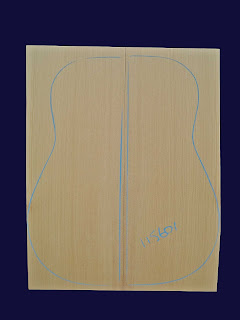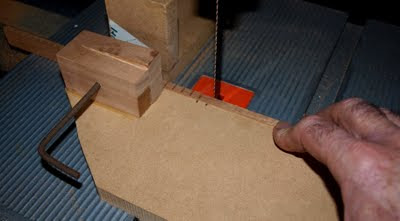Although I'm nowhere near ready to make use of them, I've spent some time lately working on the bridges destined for the two guitars I have under construction for no other reason than it's a job I can devote short periods of time to in a spare moment, or treat as light relief between more demanding or time-consuming tasks.
To facilitate drilling of the bridge pin holes in a perfectly straight line, parallel to the saddle slot I've previously routed out, I glue a small wooden block to the front edge of the bridge blank on the treble end prior to cutting the bridge outline. I trim the block carefully using my disk sander so that as the bridge is slid along a makeshift fence attached to my bench drill's table, the centre of each hole will be equidistant from the slot. Having guaranteed alignment in that direction, I need only take care then to align the bit with the string spacings marked on the bridge as I prepare to drill each hole (a white ball-point pen is a godsend when marking dark woods like this ebony). A brad-point bit makes accurate alignment much easier and produces a perfectly clean hole provided it breaks out through the lower surface of the bridge into a backing board of MDF or scrap timber.
With the bridge pin holes drilled parallel to the line of the saddle, there's a consistent break angle for the strings as they pass over it. While some reason that this guarantees an equal downward string pressure along the saddle's length, the fact that string gauges and tensions vary from string to string casts doubt on the validity of that argument. A slight increase in the saddle's height towards its centre and the potential use of radically altered tunings such as "Orkney" tuning (CGDGCD low to high) complicate the matter still further. Whatever its other merits though, it's a neat look and I'm assured of adequate downward pressure on the saddle and therefore good transference of the strings' energy to the soundboard.
To facilitate drilling of the bridge pin holes in a perfectly straight line, parallel to the saddle slot I've previously routed out, I glue a small wooden block to the front edge of the bridge blank on the treble end prior to cutting the bridge outline. I trim the block carefully using my disk sander so that as the bridge is slid along a makeshift fence attached to my bench drill's table, the centre of each hole will be equidistant from the slot. Having guaranteed alignment in that direction, I need only take care then to align the bit with the string spacings marked on the bridge as I prepare to drill each hole (a white ball-point pen is a godsend when marking dark woods like this ebony). A brad-point bit makes accurate alignment much easier and produces a perfectly clean hole provided it breaks out through the lower surface of the bridge into a backing board of MDF or scrap timber.
It seems there's no hard and fast rule where bridge weights are concerned; popular wisdom has values falling within a fairly wide range. Given that there are a multitude of factors influencing the guitar's sound, I somehow doubt I'll ever build enough instruments to draw any meaningful conclusions where small variations in bridge weight are concerned; there are so many other variables likely to have a more significant and measurable effect should I feel the urge to experiment. That being the case, I'm happy to aim for a more or less consistent bridge weight from one guitar to the next. With ebony bridges such as these, I shoot for a weight of between 30 and 35 grams, making use of a cheap digital gram scale as I shape and shave the bridge wings to their final thickness.
Useful links:
Routing the Saddle Slot
Useful links:
Routing the Saddle Slot
Cheers
Pete
























